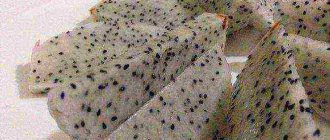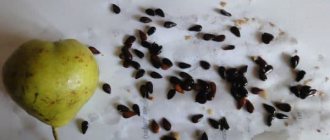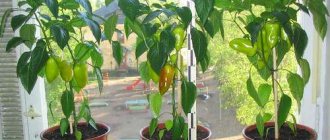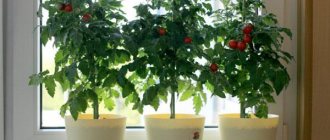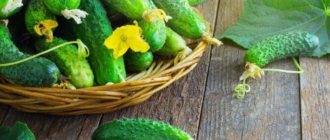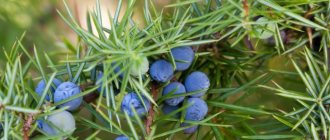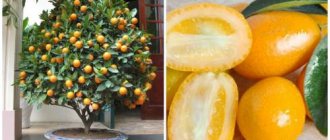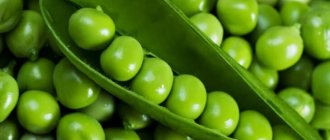Description of pepino
Melon pear is an evergreen shrub of the nightshade family. It has leaves like peppers or potatoes; the flowers are no different from potato flowers; the bush grows slowly at first, like an eggplant; You need to care for them like you would for tomatoes. Only the fruit is unique. Depending on the variety, it can be round, cylindrical, heart-shaped, or elongated oval. The skin is yellow or orange with purple stripes.
Melon pear blossoms
When cut, pepino looks like a melon: there are thick fleshy walls (4–5 cm) and a seed chamber. There are very few or no seeds inside. The consistency of the pulp resembles a pear; in overripe fruits it is juicy and melts in the mouth. The taste can be both sweet dessert and simple vegetable, reminiscent of pumpkin, cucumber or zucchini. The aroma is always melon, it can be bright or faint.
Almost all pepino have a round shape, tapering towards the tip, are colored in different shades of yellow with dark stripes, and when cut they look like a melon or pumpkin
Pepino is propagated by cuttings. They can be ordered online from amateur breeders or private collectors. Seeds are sold in regular gardening stores. If they are not available in your city, then order online, for example, at the Gavrish store. This company, by the way, has developed two varieties of pepino, zoned for all regions of the Russian Federation: Ramses and Consuelo.
Video: how Consuelo and Ramses grow
Melon pears are grown in a greenhouse, open ground and on a windowsill. Pepino from seeds often does not reproduce the parent properties. From one bag you can grow plants that differ in leaf shape, fruit size and taste.
Popular varieties of the pepino plant
Many people are interested in: “What is pepino and how to grow it?” This plant is still unfamiliar to most gardeners. Pepino is successfully grown in Australia, Chile, Peru, Israel and other countries with a suitable climate. Dutch experts believe that with proper agricultural technology, up to 30 kg of crop can be obtained from an area of 1 m2 occupied by plantings. Thanks to agricultural employees who began working on the selection of melon pears, two varieties appeared that were adapted to climatic conditions - “Ramses” and “Consuelo”.
Variety "Consuelo"
A variety obtained from Latin American pepino seedlings. The bush without formation reaches a height of 1.5 m. With proper care, the fruits ripen 120 days after the cuttings or seedlings are planted in the ground. The fruits of this variety are heart-shaped. Their color is orange, with dark lilac longitudinal stripes. The pulp is juicy, tasty, with a strong melon aroma. Fruit weight up to 580 g.
Pepino "Ramses"
A variety bred from Israeli seedlings. The fruits begin to ripen already on the 110th day after planting the seedlings in the garden. Their shape is cone-shaped, with a sharp tip. The color of the fruit is orange. The pulp is lighter, sweetish, with a delicate melon aroma. Weight up to 1 kg.
Only 25 varieties of the plant are grown in the world. Of these, only two fully bear fruit in Russia and can grow even in Siberia.
In the southern regions of the Russian Federation and Ukraine, amateurs sometimes grow foreign varieties. For example:
- "Gold";
- "Valencia";
- "Bowls";
- "Kendal" and a number of others.
There are also vegetables among them, which are indispensable for various salads. Moreover, many fruits can be stored in cool conditions for up to 1.5 months.
Disembarkation and care
Plant Pepino in a greenhouse or open ground at the same time as tomatoes. Place according to the pattern - 50x50 cm. This culture forms ovaries at temperatures no higher than +27 °C and no lower than +18 °C. The first fruits appear in May-June, the second wave occurs at the end of August - September. The landing location depends on the region:
- In the middle zone and Siberia, it is advisable to grow it in a greenhouse or in open ground, in the sunniest areas.
- In the southern regions, where the temperature drops below +30 °C only at the end of summer or autumn, pepino is grown in open ground, under the open shade of trees.
If the melon pear does not have enough light and warmth, then its fruits will grow insipid, like a zucchini or cucumber.
Video: pepino in southern Ukraine
Care for pepino:
- Be sure to tie the stems.
- Form in open ground into 1 stem, in a greenhouse - into 2-3. Stepchildren are difficult to break off; use pruning shears to avoid damaging the stems.
- Feed once a week with complex fertilizers for tomatoes, eggplants and peppers. The optimal NPK ratio is 5–10–10 or 0.5–1-1, that is, there should be half as much nitrogen as potassium and phosphorus.
- If you see that summer is already coming to an end, and there are still a lot of ovaries and flowers on the bushes that will not have time to turn into edible fruits, then remove them. Leave only the largest pepino in the bunches.
- Protect from pests: Colorado potato beetle, aphids, mites, whiteflies.
- Water, avoiding drying out and stagnation of water, loosen and mulch the soil.
It has been noticed that Consuelo sets more fruit in the spring, and Ramses - in both spring and autumn. The sweetest fruits come from spring pollination.
Pepino is contraindicated. Reviews about the fruits
Pepino has few contraindications. These are allergies and personal intolerances. Nutritionists mention one more warning: the beneficial properties of exotics appear only if they are not abused. If you eat too many berries, you may experience skin allergies and a slight deterioration in your health - typical reactions to southern fruits.
Advice. When eaten raw, the berries are eaten like melons, with the skin removed. The seeds are located deep in the pulp. But they are not tough and do not spoil the taste at all, so they are eaten too.
Russian gourmets, judging by online reviews, most often get acquainted with pepino while on vacation in Turkey. The cost of the fruit is quite high, and the taste is much inferior to melon, cucumber, and banana, with which the berries are compared. Although the pulp is very juicy. But many do not advise buying pepino or recommend eating it only in salads. The point may be that unripe fruits are usually sold at the market and in the supermarket. They differ strikingly in taste from ripe ones (in the negative direction). People who have tried ripe berries speak positively about them. Pepino is especially liked by gardeners who grew the berries with their own hands.
Harvest, appointment of pepino
The ovaries formed in spring and early summer ripen on the bushes by July-August, and a second autumn harvest in the middle zone can no longer be obtained. You can collect fruits that are full and just beginning to color. They will ripen at home, just like tomatoes. Treat the melon pear harvest with care; the pulp of ripe fruits is crushed and quickly deteriorates in areas of damage.
Salads and desserts are made from pepino, jams, jams, and compotes are made. Unsweetened varieties are added to soups, sauces, meat and fish dishes. Pieces of pulp can be pickled, dried, or frozen.
Video: a child tasting pepino
Beneficial properties of pepino berries
The valuable qualities of the melon pear are manifested in prevention and treatment:
- Kidney and liver dysfunction. Substances contained in the fruit accelerate the regeneration of organs and their mucous membrane in particular.
- Cardiovascular diseases. The likelihood of developing myocardial infarction, arrhythmia, varicose veins, atherosclerosis, anemia, and angina is reduced. The general condition of the system improves: high elasticity of the walls of blood vessels, blood properties and the level of intercellular communication are maintained.
- Gastrointestinal disorders. The low acid content in the pulp makes it absolutely harmless to the mucous membrane of the stomach and intestines. Peristalsis, microflora, and metabolism are normalized. The fruits relieve problems with stool.
- Diabetes. Fructose in these berries reduces fatigue and maintains normal levels of substances in the body of a patient with diabetes.
Pepino helps maintain human health
- Oncological diseases. Eating pepino reduces the risk of developing cancer in the body.
- Blood and blood vessels. Berries improve blood clotting and, as a result, wound healing.
- Nervous system disorders. The fruits have a sedative effect, relieve emotional fatigue, irritability, and normalize sleep.
- Disorders of the functioning of the musculoskeletal system. Berries strengthen bones and promote tissue fusion.
Pepino is recommended for use for rheumatism, skin diseases, and high blood pressure. It helps with diseases of the upper respiratory tract, osteoporosis, hemophilia, and during diets. The peel of the fruit is also edible, although not as tasty. It contains many natural antioxidants that have strong disinfecting and anticancer properties.
Cuttings of pepino and saving bushes for next year
In most of Russia, pepino fruits do not produce seeds. To preserve planting material until next year, the bushes are cut to half in the fall, dug up by the roots, transplanted into buckets or tubs and kept in a cellar or basement. During storage, the soil must be moistened occasionally to prevent the roots from drying out. At the end of February, the plants are brought into the house, placed in a sunny window, watered and fed. With the onset of warmth, the melon pear is moved to the garden bed.
When young shoots grow on old bushes, the excess ones are cut off and rooted. Pepino cuttings actively produce roots even in a glass of water. You can pick stepsons in August from a bush growing in the garden bed, and in the spring from seedlings that begin to branch already on the windowsill. It has been noticed that the stepsons from the upper part of the bush are more precocious than those from the lower part. Pepino can also be grown indoors all year round without a dormant period, if it is possible to provide additional light for 14–16 hours a day.
Video: pepino cuttings
Composition and calorie content of melon pear
The pulp of the fruit contains the following substances beneficial to the human body:
- vitamins: A, K, group B, nicotinic acid, etc.;
- minerals: magnesium, iron, potassium, iodine, copper, etc.;
- tannins;
- coarse dietary fiber and pectins;
- sugars of natural origin;
- fruit acids.
Due to the fact that the pulp contains quite a lot of sugars, the fruits have a high calorie content compared to other fruits - about 80 kcal per 100 g of edible part.
Seed propagation method
The plant reproduces well using seeds. They can be purchased at the store or taken from a well-ripened fruit. Working with seeds includes several simple techniques:
- The seed material is laid out on a damp cloth, wrapped and placed in a transparent container. The jar is hermetically covered and placed in a warm place, protected from light.
- The seeds should hatch within a week. After they swell, the jar is moved to a well-lit place.
- It is necessary to ventilate the seeds and moisten the napkin.
- You need to carefully monitor the condition of the cotyledons. Pepino seeds are planted as they open. Pre-prepare glasses with fertile soil.
- The seedlings are carefully placed in the recesses along with the remains of a paper napkin. To create a greenhouse effect, a plastic bag is placed on each pot of seed.
Gardeners who have already encountered the propagation of this crop have noticed that pepino seeds do not have good germination. Based on this, the method described below is more effective.
Propagation by seeds (germination)
The second method of reproduction is a little more complicated. Growing pepino from seeds is labor-intensive, and their germination rate is low. Even if you specially germinate the seeds, the productivity will still not be too high. Seeds in our climatic conditions do not reach sufficient maturity, which leads to such results. But if you have patience, you can grow wonderful pepino this way.
Seeds take a very long time to germinate. It takes up to one month for the first signs to appear. Preparing the seeds for planting is important here. True, when sown in the soil, only a few germinate. You can use plastic cups or jars as containers. The bottom of the container is lined with filter paper, which is moistened with water. Seeds are placed in it and removed to a warm place where the temperature does not exceed 28 degrees. When shoots appear, the containers are moved under a fluorescent lamp. The seeds should lie there until a good sprout appears and the seed splits. If necessary, you can help the plant free itself from the seed skin, but this must be done carefully.
Diseases and pests
Pepino is susceptible to all the diseases and pests that affect nightshade crops, but it also has its own problems:
- the plant can destroy the Colorado potato beetle;
- pepino is susceptible to spider mites, aphids and whiteflies;
- Seedlings that are over-watered often have a black leg;
- overwatering of mature plants causes various rots;
- With a lack of copper, late blight develops.
Pepino should be inspected regularly and, if necessary, treated with appropriate fungicides or insecticides. Before transplanting into a pot, spraying is necessary. If problems began after pepino was brought into the house, the fungicides used are the same as in open ground; it is recommended to choose Actelik from insecticides.
How to grow pepino at home
It is believed that pepino grown from seeds and suckers ripens fruits of varying quality. On plants propagated vegetatively, they are tastier, larger and sweeter. In general, the State Register specifically states that pepino is propagated by cuttings, and this in itself is rare - usually they do not provide such information there.
Growing pepino from seeds at home
The seeds of the melon pear split, and the cuttings completely inherit the characteristics of the mother plant. But what should ordinary gardeners do? Where to get cuttings? Pepino seeds are available for sale, but the stepsons of herbaceous plants may dry out or become wrinkled by the time they arrive by mail. Even in pots, it is inconvenient to transfer the rooted parts of soft, brittle stems. You have to grow pepino from seeds. But if you like the culture, in order to improve the taste of the fruits, you can take the one with the best fruits as a mother plant.
Before growing pepino from seeds at home, you need to know:
- Sowing is carried out from late November to early December. Only in this case will the pepino bloom and set fruits of such a size that they will not fall off with the onset of long daylight hours or at elevated (but not extreme) temperatures.
- If you sow the seeds in the spring, they will sprout well and bloom actively. Perhaps the pepino will even set berries. But at best, single fruits will ripen, which will hide in the shade of the leaves, where the temperature is several degrees lower. The pepino ovaries will stop falling by the end of August. When there is room for winter maintenance of a plant more than one and a half meters high, which also requires garter, this is not a problem. Getting exotic fruits in winter is no less pleasant than in summer or autumn.
- The germination rate of pepino seeds is determined to be low. It is unknown where the information came from that all planting material will hatch 100% and turn into an adult plant. Perhaps someone was just lucky, the person shared his joy, and others followed suit. To avoid disappointment when germinating pepino seeds, you should not expect miracles from them.
Growing pepino seedlings at home
It is believed that pepino seedlings should be grown in the same way as other nightshade crops. This is only partly true - after the appearance of two true leaves and picking, the crop is really easy to care for. But while the seeds are germinating, you should not deviate from the rules; their germination rate is already poor.
Experienced gardeners sow pepino on filter paper. There the culture not only sprouts, but is also brought to the picking stage. But it’s better for beginners not to even start growing seedlings this way. Young pepino on cellulose are easy to dry out or overwater, they are very fragile, they break when transplanted, and it is difficult to separate the thin roots from the filter paper.
It's better to go the traditional way:
- For pepino seedlings intended for picking, you should choose transparent containers, such as plastic food containers with holes made in the bottom. You can plant 2-3 seeds in peat cups. Then they won't need to be dived. But in this case, you should take care of a closed transparent container, which will be used as a greenhouse for the first months.
- Drainage is placed at the bottom, covered with a layer of sand calcined in the oven or disinfected with potassium permanganate.
Soil for seedlings is placed on top, compacted (so that small seeds do not fall through), leveled, and spilled with a foundation solution. Important! It is impossible to replace foundationazole with potassium permanganate in this particular case. - The seeds are laid out on the surface of the soil.
- The germination container is covered with glass or transparent film.
- Every day the cover is removed for ventilation; if necessary, the soil is moistened with a household spray bottle.
- The temperature of pepino content is 25-28⁰ C. Deviations from this range are unacceptable! If it is not possible to provide a suitable temperature, it is better not to start germination.
- At a distance of 10-15 cm from the surface of the covering material, install a light source, or even better, a phytolamp.
They illuminate 24 hours a day during seed germination and before picking. Pepino, planted in individual cups, is illuminated all day until the third true leaf appears. Important! As the seedlings grow, the lamp should be raised higher. - Most seeds will sprout within a week, but some may take a month to sprout.
- A very important point in the development of pepino is the shedding of the seed coat by the cotyledons. They cannot always free themselves and rot. The sprouts need help: arm yourself with a magnifying glass and a sterile needle, carefully remove the shell. Care must be taken as the tiny pepinos are very fragile.
- When the third true leaf appears, the seedlings are planted in individual cups. After a week, the backlight is reduced to 16 hours a day. For seedlings planted immediately in a separate container, the lighting is reduced when 2-3 true leaves are fully opened.
- After a month, the backlight is reduced to 14 hours. By the beginning of March they switch to natural mode, of course, if the seedlings are on the windowsill. Otherwise, lighting conditions are made as close to natural as possible.
- Water the soil regularly to keep it slightly moist. It should be borne in mind that with artificial lighting it dries out faster. Both a one-time lack of moisture and overwatering, which can cause blackleg and death of seedlings, are unacceptable.
- The first fertilizing is applied two weeks after picking.
Pepino, sown immediately in individual containers, is fertilized in the phase of the third true leaf. To do this, use a special fertilizer for seedlings or dilute a regular complex fertilizer 2-3 times more than what is written in the instructions. In the future, fertilize every 2 weeks. From March you can give complete fertilizing for nightshade crops. Fertilizers must be dissolved in water. Important! Pepino in a pot is watered 10-12 hours before feeding. - The melon pear grows very slowly, when it has 6-8 true leaves, transfer it into a container with a volume of 700-800 ml so as not to disturb the earthen lump.
Growing pepino from cuttings
The melon pear forms many stepsons that need to be broken out regularly. They take root well and inherit their mother’s characteristics. So, even from one sprouted seed in a season you can get so many young plants that it is enough to plant a small plantation.
Pepino grown from cuttings and stepsons develop much faster than those obtained through seedlings. It is enough to cut off the lower leaves and place a piece of the stem in water or plant it in light soil. Roots form quickly and survival rate is high. There is no need to cover the cuttings with film, but they need to be sprayed frequently.
Pepino, taken out of the ground along with a lump of earth and planted in a pot, can be easily stored in the apartment. In the spring, cuttings are cut from the stems and rooted. In contrast to the difficulties that seeds can cause, even a teenager can cope with vegetative propagation of pepino.
Important! Rooted cuttings are watered only when the soil dries to the depth of the first phalanx of the index finger.
Planting seedlings in the ground
Pepino is transplanted into open ground in early May. Three to four kilograms of compost are added to the soil per square meter. If it contains few nutrients, then you should take 6-7 kg of compost and add ash to it. The distance between rows should be at least 70 cm. Seedlings are planted in a checkerboard pattern at a distance of about half a meter from each other. Each bush must be planted a couple of centimeters lower than it grew in the container. After planting, pepino should be watered and mulched with dry soil. Repeat watering after two to three days.
How to eat pepino fruit
Residents of Japan and South America eat pepino fresh, removing the peel and removing the core and seeds. New Zealanders add fruits to meat and fish, and prepare sauces and desserts from them. Pepino can be added to compotes and made into jams. Due to the high content of pectins, the fruits make excellent jelly.
Interesting! Unripe pepino is edible and has a cucumber-like taste.
Fruits at the stage of technical ripeness can be stored for up to 2 months until they ripen.
Features of cultivation
Date fruits - a fruit-bearing tree at home
There is a lot of hassle with growing melon pears - the Russian climate is not suitable for the plant, and you have to constantly monitor the temperature and humidity in the room. But how much joy you can experience by raising an exotic pet on your own.
Melon tree indoors
Lighting
Pepino loves light and does not tolerate drafts; according to these indicators, you need to choose a place to grow it.
Watering
It is necessary to moisten the soil as it dries, in small portions. For the superficial root system of a melon tree, excess moisture is detrimental. For watering, you need to use settled water at room temperature so that the delicate pepino does not become capricious.
Temperature
The optimal temperature for growing melon pear is 20-25°C. The critical point is 14°C; if the thermometer drops below, the plant may die.
Shaping and garter
To prevent thin shoots from breaking and growing upward, they must be tied up. Experts recommend forming pepino in 1-2 shoots. All young stepsons must be carefully broken off by hand. Directed towards the sun, a properly formed plant produces abundant fruits, which have time to ripen under the sun's rays and receive all the nutrients from a few shoots.
The soil
The plant needs soil with neutral acidity, with a small nitrogen content (otherwise pepino will begin to produce excess green mass to the detriment of fruiting). The temperature of the growing soil should not fall below 20°C.
Top dressing
Growth stimulants or a solution of bird droppings are used as fertilizer. Feeding begins 14 days after planting the pepino in a permanent place and is repeated once every 14-20 days.
Flowering and harvesting
2-3 months after planting, pepino begins to bloom. Lilac flowers appear on thin shoots, which it is advisable to tie to the nearest shoot so that the buds do not break off under the weight of their weight.
Bloom
During the flowering period, a homemade melon pear should be placed in a well-ventilated place and try to create the most comfortable conditions. With a sharp change in temperature and humidity, the plant can shed ovaries and buds.
Important! Pepino is a self-pollinating plant, but it can be “helped” by lightly tapping the support peg with your finger.
When the ovaries appear on the plant, the frequency of watering should be increased. Melon pear is a juicy fruit that requires a lot of moisture to form. However, there is no need to overwater, otherwise the fruit may crack.
Pepino ripens within 2 months. The fruit increases in size, acquires a characteristic color and aroma. To ensure longer storage, the fruits are cut with pruning shears without damaging the junction with the stem. Pepino is sent to the bottom shelf of the refrigerator and stored for 1 to 2 months, depending on the variety.
